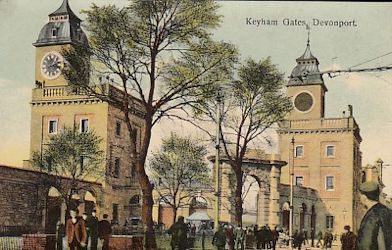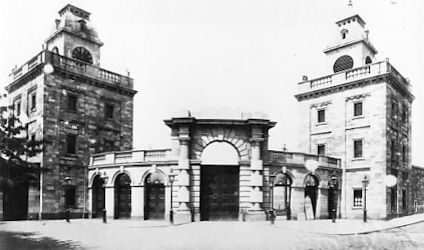|
OLD DEVONPORT
. UK |
|||
|
© Brian
Moseley, Plymouth Webpage created: February 16, 2016 Webpage updated: April 23, 2020 |
|||
|
KEYHAM STEAM YARD
The imposing main entrance to the Keyham Steam
Yard. By the end of the 1830s a quarter of the Navy's ships were powered by steam and it became necessary to build a new yard where they could receive satisfactory attention. There was much discussion about where the new facility should be situated, with one suggestion being within Saint John's Lake on the Cornish side of the Hamoaze. However, it was considered that it should be on the same side of the river as the Royal Dockyard and thus excavations started in 1844 for the Keyham Steam Yard. This was the same year that the Bristol & Exeter Railway reached Exeter. The yard displaced the Ordnance Department's Keyham Powder Works, which had to be moved further away from civilisation to Bull Point in the parish of Saint Budeaux. In preparation for the work, 38 acres of land and 43 acres of foreshore were purchased from the Trustees of the Will of Sir J Saint Aubyn.
The main gate to the Keyham Steam Yard. The contractor chosen to do the work was Messrs George Baker and Son of London, and work commenced on November 10th 1844, when the first spade went into the ground to prepare the foundation for the offices for the Clerk of Works. Then on January 30th 1845 the first pile was driven, using 'Mr Nasmyth's valuable invention the Tilt Hammer'. On February 5th 1846 work started to construct an immense coffer dam from a private wharf at Moon's Cove, Morice Town, to the pier of a powder magazine that was later removed to Bull Point. It was 1,600 feet in length and 26 feet wide, the largest so far attempted, it was said. This dam included, between the foreshore and the high water mark, some 50 acres of mud. The material excavated to form the docks was used to fill Keyham Creek, which at that time stretched inland to Ford Hill and beyond. At the time of the laying of the foundation stone (see below), some £130,000 had already been spent on the dam, nearly 150,000 cubic yards of ground (well, mud!) had been excavated and nearly 207,000 cubic feet of granite and 350,000 cubic feet of limestone had been delivered to the site. At Midday on Saturday September 12th 1846, the Right Honourable the Earl of Auckland, GCB, First Lord Commissioner of the Admiralty, laid the foundation stone within the wall of the South Lock at the entrance to Basin Number 2. The rectangular granite block came from Par Quarries near Fowey in Cornwall and weighed nine tons. It measured 12 feet 10 inches by 2 feet 7 inches and was 3 feet 6 inches deep. Beneath the stone were deposited the coins of the realm, above which was placed a brass plate upon which was the inscription:
After the ceremony the contractors entertained the Lords of the Admiralty and 200 officials and friends to dinner in the model loft, while 750 workmen were also treated to a dinner in a temporary shed on the site. Mr Moorshead of the Royal Hotel, Fore Street, Devonport, provided the catering for the officials and Mr Thomas, cook and confectioner of Saint Aubyn Street provided that for the workmen. The new yard occupied an area of 74½ acres. When the Yard was first proposed the cost was to be £400,000. By 1849 this had risen to £1,322,627. A familiar situation to us in modern times. Water was let into the South Lock on Saturday May 4th 1850 and into the Docks and Basins in May 1853. North Yard was officially opened when HMS "Queen" sailed in to the Basin on Thursday October 7th 1853. The steam yard was first lit by gas in November 1846. It was supplied by the Devonport Gas and Coke Company from their gasworks just across the main road. Within the Steam Yard was built a very extensive Quadrangle, behind which is the Iron Foundry, easily recognised from afar by its massive twin chimneys. At the bottom of Albert Road, Morice Town, is the Albert Road or South Gate. This imposing structure was based on a design produced by Mr William Scamp of the Admiralty Department of Works. It had two towers, one containing a clock and the other the Dockyard "hooter". The Steam Yard was joined to the old Dockyard by means of a tunnel about three-quarters of a mile in length and through which one of Taylor's traction engines used to draw stores, etc., up to ten tons in weight at a time. Authorised by an Act of Parliament in 1854, the tunnel was commenced in April 1855 and brought into use during May 1857. The tunnel was 12 feet high and 18 feet wide and was originally lit only by shafts in the roof. The Dockyard Railway was eventually extended through the Tunnel to both the Gun Wharf and the original Dockyard. A new gate, apparently called the Ford Gate, was opened at the northern end of the Yard on July 19th 1869. Close to this Gate was fixed a gas light in a glass case for the Dockyardees to light their pipes before or after leaving work so as encourage them not to take matches into the Yard. Such was three serious risk of fire that anyone caught with matches would be instantly dismissed. The Gate still exists, opposite the old entrance to the Devonport Gas Works, although it was replace by the Saint Levan Gate in 1900 when Keyham Road was lowered by 6 feet at one point and raised by 4 feet at the bottom. Keyham Steam Yard operated completely separately until it was integrated into the Royal Dockyard in 1876. Finally, as from November 1903, the Keyham Steam Yard was henceforth to be known as the North Yard and the are surrounding the First Dock became the South Yard.
|
|||

